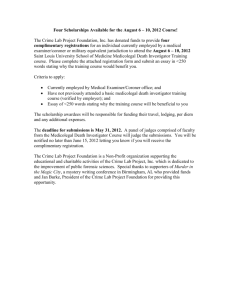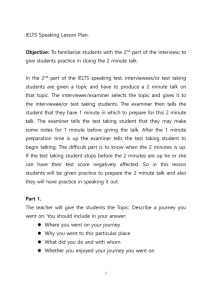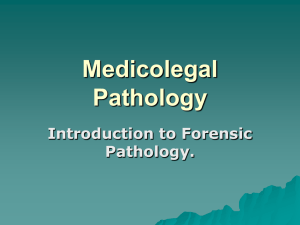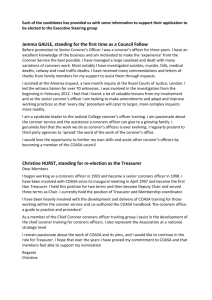Autopsy and Religious Beliefs Guidelines
advertisement
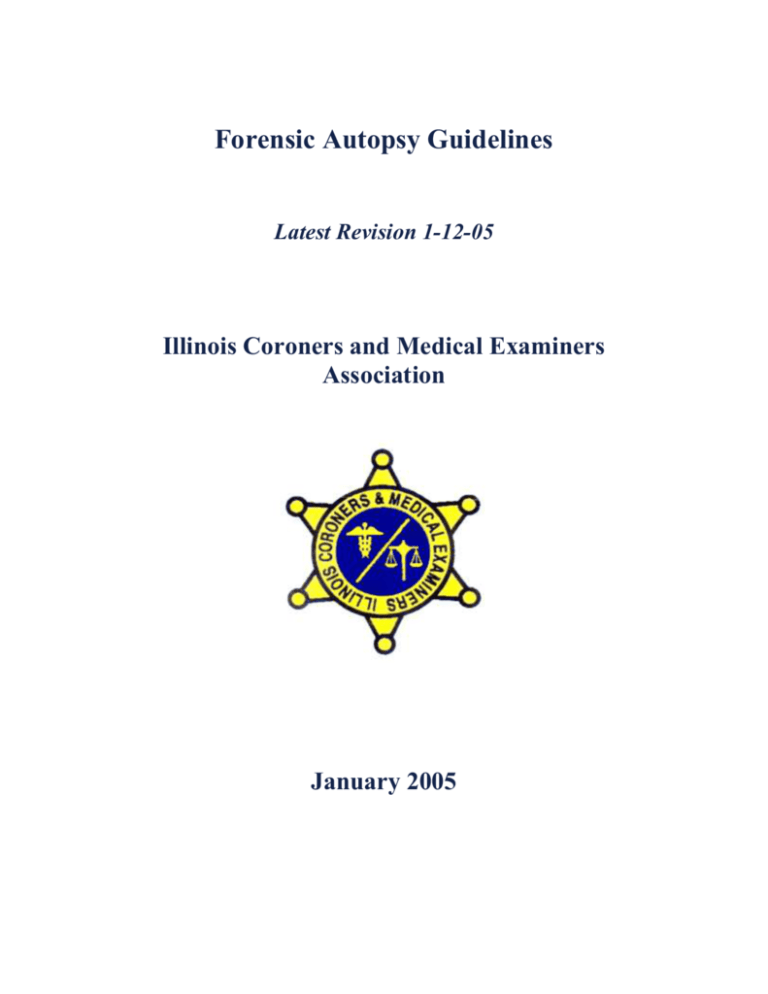
Forensic Autopsy Guidelines Latest Revision 1-12-05 Illinois Coroners and Medical Examiners Association January 2005 Background and Introduction The annual meeting of the Illinois Coroners and Medical Examiners Association was held in November 2004 in Chicago, Illinois. During the meeting, a discussion was held noting that some national pathology organizations had developed practice guidelines and specific practice standards for the performance of forensic autopsies which would apply to coroners and medical examiners in Illinois. Upon review, these documents were not necessarily specific or relevant to the practice of forensic pathology and performance of death investigation within the state of Illinois. Illinois is classified as a "mixed-system state" of 101 elected County Coroners each serving their own jurisdiction's death investigation needs, while utilizing trained coroner’s pathologists for autopsies. This is contrasted to one appointed Chief Medical Examiner of Cook County with assistant medical examiner forensic pathologists, encompassing Chicago and its surrounding suburbs. Coroners are responsible for determining the manner of death after investigation and completion of the post mortem examination, often utilizing the inquest jury. The medical examiner determines both cause and manner of death after investigation and autopsy without inquest. Based on the jurisdictional differences within Illinois, and the fact that the Illinois Coroners Handbook had not been updated since its inception in the 1960's, it was decided that an ad hoc committee would be formed to develop consensus guidelines for the performance of forensic autopsies in the state of Illinois. The general agreement was that these guidelines should be such that they aid and guide county coroners, coroner’s pathologists, and medical examiners of Illinois in proper procedures for forensic autopsies in conjunction with thorough death investigations, without resorting to mandatory formulas of rote performance. In December of 2004, ICMEA President Coroner Jodeen Bernard of LaSalle County formed the ad hoc Forensic Autopsy Guidelines Committee. The President charged the committee to draft a document, present it for initial review to the ICMEA members, review the expected comments and concerns, revise the document accordingly, and then submit a final document for approval by the membership of guidelines for performance of an autopsy by an Illinois Coroners Pathologist or Medical Examiner within Illinois. It is important to note that these Illinois guidelines are not meant as standards for the medical practice of an autopsy. A "standard" is defined as a universally accepted principal for investigation and examination of the deceased. A "standard" is by definition, rigid, and would not allow for any deviation, as may be required in a specific case. In other words, the use of judgment by the physician or coroner is not permitted. Conversely, this document contains "guidelines", which are defined as recommendations, or "best practices" for forensic autopsy performance within the state of Illinois. These guidelines importantly recognize that every death investigation has unique characteristics and circumstances: that no two individuals are the same, either in personal, medical or family history. The performance of a postmortem examination is strongly driven by these investigative circumstances and medicolegal questions surrounding the death. These circumstances and questions frequently change and evolve as an investigation continues, necessitating flexibility in the autopsy approach. An autopsy practice variation within these guidelines is deemed reasonable if the end result is documentation and transmission of essential information from the post mortem examination in answering the important questions. It is important to note that an autopsy is the practice of medicine, requiring skills and judgment exercised by a specially trained physicianpathologist in a proper environment. This proper environment should be suitable or designed to properly accommodate the trained physician-pathologist and meet minimum specifications for autopsy. Illinois is a large state with very diverse size, population, and needs for each county within the state. Therefore, the facility for autopsy should be at the discretion of the individual county coroner and pathologist based on the individual needs of each case. These guidelines are not meant to interfere or conflict with any Illinois laws regarding the responsibilities and performance of the duties of coroners or medical examiners, but to guide Illinois coroners and pathologists in proper medicolegal death investigation (specifically 55 IL CS 5/1-3001, though 3044, et al). Section I - Guidelines of Medicolegal Death Investigation A. These items are meant to ensure an objective and professional death investigation. 1. The medicolegal coroner and medical examiner agencies should investigate cooperatively with, but also operate independently from, law enforcement agencies and prosecutors. 2. A properly trained death investigator, such as the coroner, deputy coroner, medical examiners death investigator, or police representative, shall investigate the circumstances surrounding all reported deaths, depending on local jurisdiction. 3. Medicolegal death investigators assess each death reported to the office to determine whether it falls under their jurisdiction as outlined by statutes, rules, and regulations. 4. The coroner or medical examiner agency involved should investigate all: 5. a. deaths due to violence. b. known or suspected non-natural deaths. c. unexpected or unexplained deaths when in apparent good health. d. unexpected or unexplained deaths of infants and children. e. deaths occurring under unusual or suspicious circumstances. f. deaths of persons in custody. g. deaths known or suspected to be caused by diseases constituting a threat to public health. f. deaths unattended by a physician. An investigation into a death does not imply that an autopsy should be performed, or that the death be accepted by the coroner or medical examiner jurisdiction. The medical examiner or coroner's office makes these decisions based on criteria of that jurisdiction. Section II - Forensic Autopsies A. Guidelines for selecting deaths requiring autopsies 1. A medical examiner or coroner's pathologist should perform an autopsy when: a. the death is known or believed to have been caused by criminal violence. b. the death is unexpected and unexplained in an infant or child. c. the death is associated with police activity. d. the death occurs while in the custody of a local, state, or federal institution. e. the death is due to a workplace injury, or occurs at work. f. the death is caused by electrocution. g. the death is associated with intoxication by alcohol, drugs, or poisons. h. the death is a suspected unwitnessed drowning. i. in certain circumstances, and as needed, an autopsy may be performed if the body is unidentified, skeletonized, or charred beyond recognition. j. in motor vehicle accidents if there is insufficient apparent injury, either upon external examination or by radiology studies, to determine the cause of death. k. if needed for identification purposes, and at the discretion of the coroner or medical examiner, prior to disposition of an unidentified body. B. The coroner's pathologist and medical examiner should optimally be a trained forensic pathologist, especially when legal proceedings are anticipated. C. The number of autopsies performed by the medical examiner or coroner’s pathologist should not be limited; however, the chief medical examiner or coroner of jurisdiction should assess the pathologist’s quality of work. 1. Guidelines for the pathologist's general responsibilities are that: a. the designated pathologist or supervised resident in pathology performs all autopsies. b. the pathologist personally and directly supervises all assistance rendered during postmortem examinations. c. the pathologist performs all ex situ dissections, or directly supervises the pathology resident's dissection. d. the deputy medical examiner or coroner's pathologist determines the need for special dissections or additional testing to determine the cause of death or answer anticipated medicolegal questions. e. the medical examiner or coroner's pathologist reviews and interprets all lab results. f. the medical examiner or coroner's pathologist reviews all ancillary and consultative reports. g. the medical examiner or coroner's pathologist determines cause of death. h. in the coroners' jurisdiction, the coroner may hold an inquest to determine manner of death, or determine the manner in consultation with the pathologist. i. in the medical examiner jurisdiction, the medical examiner determines cause and manner of death. j. the coroner's pathologist or medical examiner assesses the sufficiency of presumptive identification. k. the coroner's pathologist, medical examiner pathologist or designee takes identification photographs with case number in photograph. l. the coroner's pathologist or medical examiner oversees the collection of specimens for possible toxicologic, DNA or other laboratory studies. Section III - Guidelines for External Examinations A. Initial examination procedures are that: 1. the coroner's pathologist or medical examiner reviews the circumstances of death prior to autopsy. 2. the coroner's pathologist, medical examiner or designee measures and records body length and weight. 3. the coroner’s pathologist or medical examiner examines and documents the external aspects of the body before internal examination. 4. the coroner's pathologist, medical examiner or designee photographs the external body as necessary for documentation 5. the coroner's pathologist or medical examiner documents defects of clothing that may later be correlated with injuries on the body. 6. the coroner’s pathologist, medical examiner or designee identifies and collects trace evidence on clothing and body surfaces as necessary. 7. the coroner's pathologist, medical examiner or designee removes clothing. 8. the coroner's pathologist, medical examiner or designee generally documents clothing and personal effects verbally or photographically, photographing any traumatic defects. 9. the coroner's pathologist or medical examiner documents the apparent age and gender. 10. the coroner's pathologist or medical examiner describes the apparent race. 11. the coroner's pathologist or medical examiner describes the head hair. 12. the coroner's pathologist or medical examiner describes the eye color and any abnormalities. 13. the coroner's pathologist or medical examiner describes an abnormal body habitus. 14. the coroner's pathologist or medical examiner documents prominent scars, tattoos, skin lesions, and amputations. 15. the coroner's pathologist or medical examiner documents presence or absence of dentition. 16. the coroner’s pathologist or medical examiner inspects and describes head and facial orifices. 17. the coroner’s pathologist or medical examiner inspects and generally describes the neck, thorax, abdomen, extremities, and hands. 18. the coroner’s pathologist or medical examiner inspects and describes posterior body surface, anus, and genitals. 19. the coroner's pathologist or medical examiner documents evidence of medical or surgical intervention. 20. the coroner's pathologist or medical examiner describes any livor and rigor mortis. 21. the coroner's pathologist or medical examiner describes any postmortem, embalming or predation artifacts. 22. the coroner's pathologist or medical examiner describes the extent of any decomposition changes. SECTION IV - Special Procedures for Suspected Sexual Assault A. In cases of suspected sexual assault, or with other selected cases, prior to the cleaning of the body or internal autopsy, the coroner’s pathologist, medical examiner or designee should, in cooperation with local law enforcement: 1. collect swabs of oral, vaginal, and rectal cavities. 2. collect pubic hair combings. 3. collect fingernail scrapings or clippings. 4. collect pubic and head hair standards. 5. identify and collect foreign hairs, fibers, and biological stains. 6. swab any suspected bite mark. 7. ensure proper chain of custody documentation to the recipient legal agency or department. Section V - Guidelines for Description and Documentation of Injuries A. Generally, the coroner’s pathologist or medical examiner should, if applicable: 1. describe injury by type (i.e. gunshot wound, stab, laceration, abrasion, contusion) 2. describe injury by location. 3. describe injury by size. 4. describe injury by shape. 5. describe injury by pattern. 6. obtain photographs of injuries so that images are clear, appropriately documented with a scale, and useful for medicolegal purposes. B. In case of Firearm Injuries, the coroner's pathologist or medical examiner should: 1. measure entrance and exit wound defect sizes. 2. locate cutaneous wounds of the head, neck, torso, or lower extremities by measuring from the top of the head, and from either the anterior or posterior midline. 3. locate cutaneous wounds of the upper or lower extremities by measuring from anatomic landmarks (i.e elbow, knee). 4. describe presence or absence of soot and stippling around entrance wounds. 5. describe presence of abrasion ring, searing, muzzle imprint, or lacerations. 6. correlate internal injury to external injury. 7. describe and document the path of the wound through the body, including involved organs, major blood vessels, and associated hemorrhage. 8. describe and document the direction of wound through the body. 9. recover, describe and document recovered firearm projectile(s). C. In cases of Sharp Force Injuries, the coroner's pathologist or medical examiner should: 1. describe wound, and indicate if stab or incised, if appropriate. 2. measure wound size. 3. locate wound in anatomic region. 4. correlate internal injury to external injury. 5. describe and document the track of wound into the body, including any involved organs, blood vessels, or associated hemorrhage. 6. describe and document the direction and estimated depth of the wound. 7. recover, describe and document recovered any foreign body (i.e. broken blade). D. In case of Blunt and Patterned Injuries, the coroner's pathologist or medical examiner should: 1. measure injury size. 2. describe location of injury. 3. describe injury pattern. 4. correlate internal injury to external injury. 5. describe and document injuries to skeletal system. 6. describe and document injuries to internal organs, structure, and soft tissue. 7. photograph any significant patterned injury after cleaning with a scale. E. In Burn Injuries, the coroner's pathologist or medical examiner should describe and document the appearance and distribution of the burn. SECTION VI - Ancillary Radiographic Studies Prior to the autopsy or internal examination, the coroner, coroner's pathologist, medical examiner or assistant should: 1. obtain total body radiographs on all infants. 2. obtain total body radiographs on all explosion victims. 3. obtain necessary radiographs on all gunshot victims. 4. obtain radiographs or total body fluoroscopy on all charred victims. SECTION VII – Guidelines for Performance of the Internal Examination A. Upon examination of the thoracic and abdominal cavities, the coroner's pathologist or medical examiner should: 1. examines internal organs in situ. 2. describe any fluids or adhesions. 3. describe and document any abnormal position of medical devices. 4. describe evidence of surgery. B Upon removal and examination of the organs from the cranial, thoracic, abdominal, and pelvic cavities, the coroners pathologist, medical examiner, or carefully supervised resident and/or medical student, with the aid of an assistant: 1. documents the measured weights of internal organs. 3. dissects and describes organs. 4. inspects and describes the scalp, skull, and meninges. 5. describes and documents any epidural, subdural, or subarachnoid hemorrhage. 6. inspects the brain in situ prior to removal and sectioning. 7. documents any purulent material or abnormal fluids. 8. inspects the inner surface of the skull after the dura has been stripped. 9. examines in situ muscles and soft tissues of the anterior neck. 10. if indicated, removes and examines the neck organs and airways. 11. if indicated, dissects the posterior neck. 12. if indicated, performs a layered anterior neck dissection. SECTION VIII – Guidelines for Collection of Toxicology Specimens A. Upon opening the body and prior to removal of the internal organs, the coroner’s pathologist, medical examiner or assistant should: 1. collect necessary and available specimens as required by the individual toxicology laboratory utilized by the coroner or medical examiners office (i.e. blood, bile, urine, vitreous humor, liver and brain tissues and gastric contents suggested). 2. collect, package, label, and submit the toxicology specimens to the appropriate laboratory in appropriate sealed containers. SECTION IX – Guideline for the Use of Histology A. histologic examination should be performed at the discretion of the coroner’s pathologist or medical examiner, most often in cases with no anatomic and or toxicologic cause of death. SECTION X – Guidelines for use of Medicolegal Consultants A. Depending on the circumstances and necessity of the case, the coroner’s pathologist or medical examiner should utilize as necessary: 1. a histology laboratory. 2. a radiologist. 3. an anthropologist. 4. an odontologist. 5. toxicology and clinical laboratory testing. 6. radiographic equipment. 7. body and organ scales. SECTION XI – Guidelines for the Autopsy Report A. The coroner’s pathologist or medical examiner should: 1. prepare a written report for each postmortem examination. 2. include the date, place, and time of examination. 3. include the name of deceased, if known. 4. include the coroner or medical examiner case number. 5. document observations of the external and internal examination. 6. include a separate section on injuries with tabular listing. 7. describe gunshot and sharp force injuries correlating the internal and external wounds. 8. list any evidentiary items collected and their disposition. 9. list specimens submitted for toxicology analysis or other laboratory studies. 10. list the diagnoses in the autopsy report. 11. state the cause of death. 12. state the manner of death as appropriate to the medicolegal jurisdiction.. 13. include the name and title of each pathologist or resident involved with the case. 14. sign and date each postmortem examination report upon completion. CLOSING These forensic autopsy guidelines have been compiled to aid county coroners, coroner’s pathologists and medical examiners in Illinois with proper procedures for forensic autopsy and complete death investigations. These are suggested guidelines for forensic autopsy and should be re-evaluated or re-examined periodically to recommend adjustments as needed. The end result is to provide answers to questions arising from a medicolegal death investigation through proper procedures and thorough death investigations.
